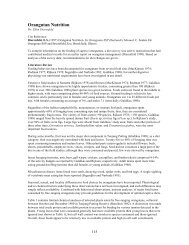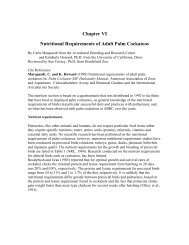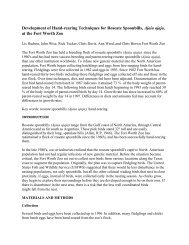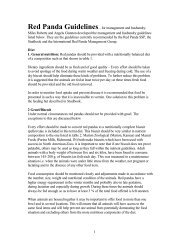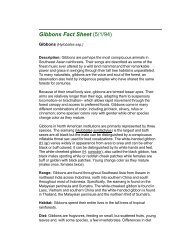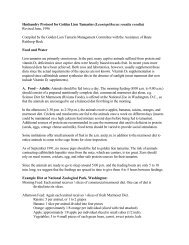Tree Kangaroo Nutrition Chapter - Nutrition Advisory Group
Tree Kangaroo Nutrition Chapter - Nutrition Advisory Group
Tree Kangaroo Nutrition Chapter - Nutrition Advisory Group
Create successful ePaper yourself
Turn your PDF publications into a flip-book with our unique Google optimized e-Paper software.
3.8 <strong>Tree</strong> <strong>Kangaroo</strong> Husbandry Manual<br />
The importance of plant fiber, or as<br />
described by some authors as "bulk", for<br />
arboreal folivores is increasingly apparent.<br />
The gastrointestinal tract of Dendrolagus<br />
species is adapted to process and utilize<br />
large quantities of relatively indigestible<br />
plant material. Although plant fiber has<br />
historically been considered a "negative feed<br />
factor," the evolutionary adaptations of the<br />
species cannot be circumvented by feeding<br />
higher quality foods available for use with<br />
captive specimens. In fact, the consumption<br />
of readily fermentable foods, such as<br />
commercially available fruits, may lead to<br />
digestive disorders like foregut acidosis that<br />
plagues some ruminant animals.<br />
The negative effects of excessive<br />
fermentation are not only limited to types of<br />
foods, but also quantities of certain foods.<br />
For example, vegetables from Brassicaceae<br />
(e.g., cabbage, broccoli) may be included in<br />
a tree kangaroo diet to elevate the fiber<br />
content of the ration. However, these foods,<br />
known for their methanogenic properties,<br />
could also lead to inappropriate fermentation<br />
in the foregut if fed in excess quantities.<br />
The proportions presented in this manual<br />
should serve as a guide.<br />
The use of browse in tree kangaroo diets<br />
varies from institution to institution.<br />
Although plant materials are not considered<br />
a primary source of nutrition for captive<br />
animals, their behavioral enrichment value<br />
and link to the prevention of loose stools<br />
make browse a desirable dietary supplement.<br />
The users should keep in mind that plants<br />
have many mechanisms (e.g., toxins) by<br />
which they protect themselves from<br />
consumption by herbivores. These<br />
mechanisms may not be apparent to the<br />
keeper or tree kangaroo. Only those species<br />
which have been demonstrated with<br />
domestic animals as non-toxic should be<br />
considered for use as browse (Appendix A).<br />
Additionally, the plant materials should be<br />
properly secured in a holder which limits the<br />
animals’ access to the bark of the plant.<br />
Plant bark is relatively high in lignin, an<br />
indigestible fraction of the plant cell wall.<br />
Although no tree kangaroos have been<br />
known to be affected, several captive<br />
primates have died due to impactions of<br />
highly lignified plant materials which were<br />
offered as browse.<br />
As previously mentioned, loose stools have<br />
been linked to a lack of fibrous plant<br />
material in a tree kangaroos' diet. Indeed,<br />
the condition of the fecal material is<br />
indicative of the animals' overall health,<br />
signaling possible underlying stress<br />
disorders or nutrition deficits when feces are<br />
not pelleted (pers. comm. Steenberg 1996).<br />
Coprophagy (consumption of fecal material)<br />
has been reported in captive adult tree<br />
kangaroos, as well as both a female and her<br />
joey (Steenberg 1995). Although<br />
coprophagy is a behavior typically<br />
demonstrated by those species with hindgut<br />
fermentation (e.g., koalas, equids, rabbits) as<br />
a method of recovering nutrients lost in<br />
feces, the significance of this behavior in<br />
Dendrolagus species is thought to be<br />
similar. It is theorized that tree kangaroo<br />
joeys are being inoculated with gut flora<br />
through coprophagy.<br />
Diets were reviewed from the National<br />
Zoological Park’s Conservation and<br />
Research Center and the Zoological Society<br />
of San Diego for D. matschiei and D.<br />
goodfellowi tree kangaroos, respectively.<br />
Both of these facilities have sizeable



